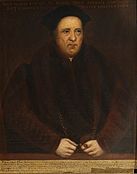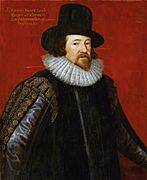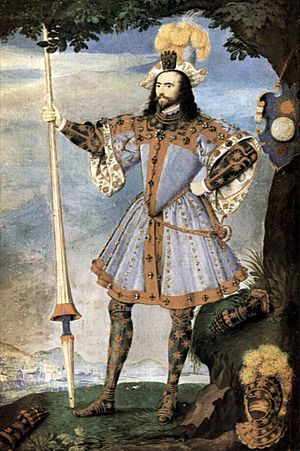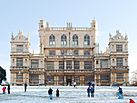English Renaissance facts for kids
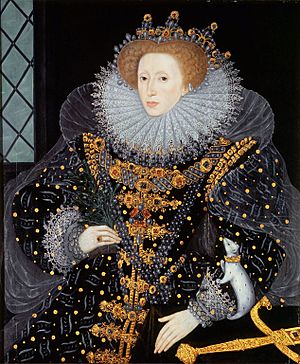
The English Renaissance was a time of great change and creativity in England. It happened from the late 1400s through the early 1600s. This period was part of a bigger movement called the Renaissance, which started in Italy in the late 1300s.
In England, the Renaissance ideas took a bit longer to arrive. The most exciting part of the English Renaissance was during the Elizabethan era (the second half of the 1500s). Some experts think it began earlier, during the time of Henry VIII in the early 1500s.
The English Renaissance was special because it was different from the Italian Renaissance. In England, the most important art forms were literature (like books and plays) and music. Visual arts, like painting and sculpture, were not as big in England as they were in Italy. Also, the English Renaissance started much later than the Italian one.
Contents
Literature: A Golden Age of Words
England already had a strong tradition of writing in English, which grew even more with the printing press in the mid-1500s. This love for English writing really took off because of the Protestant Reformation. People wanted to read the Bible for themselves, not just rely on the Catholic Church's interpretation.
This led to new English Bibles. William Tyndale published his translation in 1526. Later, Sir Rowland Hill published the Geneva Bible in 1560. These Bibles helped set the stage for the famous King James Version of the Bible.
Roger Ascham, who taught Princess Elizabeth, was another important person. He believed that speaking and writing well was a great gift. He is often called the "father of English prose."
Amazing Plays and Poets
The Elizabethan era is known as a "golden age" for English plays and theatre. It was a time when arts and creative works really shined. Early plays called Morality plays taught lessons and were popular around 1400.
By the time of Elizabethan literature, there were many great writers. Poets like Edmund Spenser wrote long poems, but the songs and poems of William Shakespeare, Thomas Wyatt, and others became even more famous. Plays from the English Renaissance theatre were the most important works of this time.
London was growing, and its people had more money and loved entertainment. This led to many different kinds of plays. Some plays were history plays, showing English or European history. Shakespeare's plays about kings, like Richard III and Henry V, are examples. Christopher Marlowe's Edward II is another.
Tragedy plays were also very popular. Marlowe's tragedies, such as Dr. Faustus and The Jew of Malta, were huge hits. Audiences especially liked revenge dramas, like Thomas Kyd's The Spanish Tragedy. Shakespeare's greatest tragedies—Hamlet, Othello, King Lear, and Macbeth—were written during this time.
The English theatre scene was very busy, with many playwrights. The most famous were Christopher Marlowe, William Shakespeare, and Ben Jonson. Queen Elizabeth I herself was very educated and even wrote poems. William Shakespeare is still seen as the greatest playwright of all time, with famous works like Romeo and Juliet and A Midsummer Night's Dream.
New Ideas in Thought
Important thinkers of this time included Thomas More and Francis Bacon. Francis Bacon and Thomas Hobbes wrote about empiricism (learning from experience) and materialism (everything is physical). Bacon's ideas helped develop the scientific method, which is how scientists do experiments today.
All the Tudor monarchs in the 1500s were well-educated. Italian literature was also very popular and inspired many of Shakespeare's plays. The language of the Book of Common Prayer (first published in 1549) and the Bible had a lasting impact on English culture.
Visual Arts: Portraits and Miniatures
England was slower to adopt Renaissance styles in visual arts. Many artists at the artists of the Tudor court were from other countries, like Hans Holbein. The English Reformation destroyed much of the old religious art, and painting skills in England almost disappeared. For centuries, English art would mostly be about portrait painting.
A special English invention was the portrait miniature. These were tiny, detailed portraits, often worn in lockets. They used techniques from illuminated manuscripts (decorated books). While foreign artists first developed this art in England, English artists like Nicolas Hilliard and Isaac Oliver later created the best ones. Portrait miniatures became popular across Europe.
The portraiture of Elizabeth I was carefully controlled. Her portraits were not always realistic but used many symbols to show her power. Early portraits included symbols like roses and prayer books. Later ones added symbols of empire (like globes and crowns) and virginity (like moons and pearls). The famous Armada Portrait shows the queen surrounded by symbols of her empire and the defeat of the Spanish Armada.
Music: English Sounds
English Renaissance music was more connected to music from other European countries than visual art was. It also survived the Reformation quite well, even though some major composers like William Byrd were Catholic. The Elizabethan madrigal was a type of song that was similar to Italian madrigals but had its own English style.
Other important English composers included Thomas Tallis, Thomas Morley, and John Dowland.
Early Composers and New Styles
Some early Renaissance composers also wrote in an older, medieval style. Leonel Power (who lived from the late 1300s to 1445) was a key English composer. He was one of the first to write different parts of a church mass that were connected by a theme.
John Dunstaple (around 1390–1453) was another very famous English composer. He had a huge influence on music in Europe, especially in the Burgundian School (a group of composers). People called his style la contenance angloise or "the English countenance," meaning it had a special English sound.
The big, multi-choir music of the Venetian School and the style of Palestrina from the Roman School were already known in England.
Madrigals and English Poetry
Both Italian and English Renaissance music shared a similar beautiful sound. In the late 1500s, Italy was the music center of Europe, and the madrigal was a very popular song form.
In 1588, Nicholas Yonge published Musica transalpina in England. This was a collection of Italian madrigals that had been translated into English. This started a huge trend for madrigals in England. English poetry, especially the sonnet, was perfect for setting to music as madrigals. Composers like Thomas Morley, who wrote music for Shakespeare's words, created their own English madrigals. Today, there's a lot of interest in the music of the English Madrigal School.
Architecture: Grand Houses and New Designs
Some buildings from the time of Henry VIII (early 1500s) had a bit of Renaissance style, like Hampton Court Palace (started in 1515). But a true Renaissance style didn't become common until the Elizabethan era.
During Queen Elizabeth's reign, farming became very successful, making many people wealthy. Elizabeth didn't build new palaces for herself. Instead, she encouraged her wealthy friends to build amazing houses and host her during her summer travels. Many large country mansions were built or updated. Public buildings also became more common.
The most famous buildings were called prodigy houses. These were huge, fancy homes built for important people. They used a lot of glass, like at "Hardwick Hall, more glass than wall." Other examples include Wollaton Hall, Montacute House, and Hatfield House. This style continued into the early 1600s, leading to Jacobean architecture. Smaller but still large houses, like Little Moreton Hall, continued to be built in older, medieval styles until the late 1500s.
Church buildings mostly stayed in the old Perpendicular Gothic style. After the Reformation, very few new churches were built. However, church decorations often had classical styles.
Inside the Homes
During this time, the long gallery became popular in English manor houses. These were long rooms, often used for walking and displaying art. Families also had more private rooms, like parlours and withdrawing rooms. The main living room, called the great hall, was mostly used by servants and as an impressive entrance to the house.
Major English Renaissance Authors
Here are some of the most important writers from the English Renaissance:
- Francis Bacon
- Francis Beaumont
- Thomas Campion
- George Chapman
- Francis Hubert
- Thomas Dekker
- John Donne
- John Fletcher
- John Ford
- John Milton
- Ben Jonson
- Thomas Kyd
- Christopher Marlowe
- Philip Massinger
- Thomas Middleton
- Thomas More
- Thomas Nashe
- William Rowley
- William Shakespeare
- James Shirley
- Philip Sidney
- Edmund Spenser
- William Tyndale
- John Webster
- Thomas Wyatt
See also




